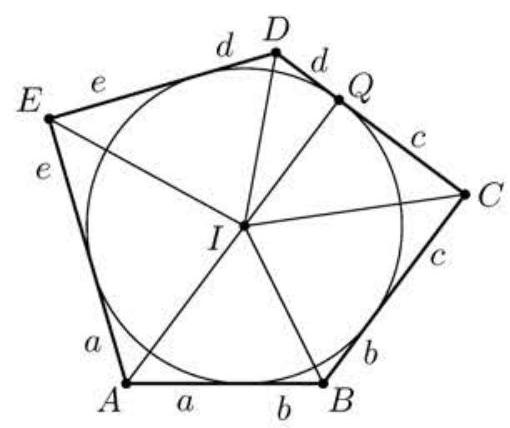Problem:
Convex pentagon ABCDE has side lengths AB=5,BC=CD=DE=6, and EA=7. Moreover, the pentagon has an inscribed circle (a circle tangent to each side of the pentagon). Find the area of ABCDE.
Solution:
Let ω be the inscribed circle, I be its center, and r be its radius. The area of ABCDE is equal to its semiperimeter, 15, times r, so the problem is reduced to finding r. Let a be the length of the tangent segment from A to ω, and analogously define b,c,d, and e. Then a+b=5, b+c=c+d=d+e=6, and e+a=7, with a total of a+b+c+d+e=15. Hence a=3, b=d=2, and c=e=4. It follows that ∠B=∠D and ∠C=∠E. Let Q be the point where ω is tangent to CD. Then ∠IAE=∠IAB=21∠A. The sum of the internal angles in polygons ABCQI and AIQDE are equal, so ∠IAE+∠AIQ+∠IQD+∠D+∠E=∠IAB+∠B+∠C+∠CQI+∠QIA, which implies that ∠AIQ must be 180∘. Therefore points A,I, and Q are collinear.

Because AQ⊥CD, it follows that
AC2−AD2=CQ2−DQ2=c2−d2=12.
Another expression for AC2−AD2 can be found as follows. Note that tan(2∠B)=2r and tan(2∠E)=4r, so
cos(∠B)=1+tan2(2∠B)1−tan2(2∠B)=4+r24−r2
and
cos(∠E)=1+tan2(2∠E)1−tan2(2∠E)=16+r216−r2.
Applying the Law of Cosines to △ABC and △AED gives
AC2=AB2+BC2−2⋅AB⋅BC⋅cos(∠B)=52+62−2⋅5⋅6⋅4+r24−r2
and
AD2=AE2+DE2−2⋅AE⋅DE⋅cos(∠E)=72+62−2⋅7⋅6⋅16+r216−r2.
Hence
12=AC2−AD2=52−2⋅5⋅6⋅4+r24−r2−72+2⋅7⋅6⋅16+r216−r2,
yielding
2⋅7⋅6⋅16+r216−r2−2⋅5⋅6⋅4+r24−r2=36,
equivalently
7(16−r2)(4+r2)−5(4−r2)(16+r2)=3(16+r2)(4+r2).
Substituting x=r2 gives the quadratic equation 5x2−84x+64=0, with solutions 542−38=54 and 542+38=16. The solution r2=54 corresponds to a five-pointed star, which is not convex. Indeed, if r<3, then tan(2∠A),tan(2∠C), and tan(2∠E) are less than 1, implying that ∠A,∠C, and ∠E are acute, which cannot happen in a convex pentagon. Thus r2=16 and r=4. The requested area is 15⋅4=60.
OR
Define a,b,c,d,e, and r as in the first solution. Then, as above, a=3,b=d=2,c=e=4, ∠B=∠D, and ∠C=∠E. Let α=2∠A,β=2∠B, and γ=2∠C. It follows that 540∘=2α+4β+4γ, so 270∘=α+2β+2γ. Thus
tan(2β+2γ)=tanα1.
tan(β)=2r,tan(γ)=4r, and tan(α)=3r. By the Tangent Addition Formula,
tan(β+γ)=8−r26r
and
tan(2β+2γ)=1−(8−r2)236r28−r212r=(8−r2)2−36r212r(8−r2).
Therefore
(8−r2)2−36r212r(8−r2)=r3,
which simplifies to 5r4−84r2+64=0. Then the solution proceeds as in the first solution.
OR
Define a,b,c,d,e, and r as in the first solution. Note that
arctan(ra)+arctan(rb)+arctan(rc)+arctan(rd)+arctan(re)=180∘.
Hence
Arg(r+3i)+2⋅Arg(r+2i)+2⋅Arg(r+4i)=180∘.
Therefore
Im((r+3i)(r+2i)2(r+4i)2)=0.
Simplifying this equation gives the same quadratic equation in r2 as above.
The problems on this page are the property of the MAA's American Mathematics Competitions
